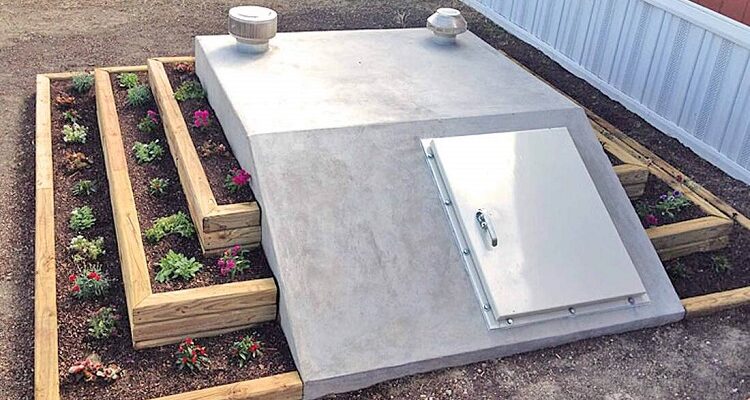Table of Contents
Key Takeaways:
- Tornadoes can form rapidly and unpredictably, emphasizing the need for preparation and storm shelters.
- Storm shelters are crucial for safety, especially in regions like “Tornado Alley,” and can increase property value.
- Above-ground shelters provide quick access but are vulnerable to flooding, while below-ground shelters offer stronger protection but may pose accessibility issues.
- The construction material of a shelter is vital; reinforced steel and concrete are top choices for durability and safety.
- Choose a shelter size that fits your family and emergency equipment comfortably; minimum recommended size is 10-14 square feet for a family of four.
- Ensure the shelter is well-ventilated and equipped with necessary comfort features and emergency supplies.
- When shopping for storm shelters, consider both local suppliers for personal consultations and online retailers for a wider selection.
- Opt for reputable manufacturers that certify their products for safety and durability.
- Decide between custom and prefabricated shelters based on unique family needs and budget considerations.
- Consider professional installation for optimal safety and compliance with building codes, as DIY installation could risk shelter effectiveness.
- Regular maintenance of the shelter is essential to ensure it is ready for emergencies.
- Stock your shelter with essential supplies, aiming for at least 72 hours worth of food, water, first-aid kits, and communication devices.
Understanding the Importance of Tornado Storm Shelters
The Science Behind Tornadoes: Nature’s Unpredictable Fury
Tornadoes are awe-inspiring yet terrifying manifestations of nature, capable of causing widespread destruction in mere minutes. Formed from severe thunderstorms, these rotating columns of air can reach wind speeds exceeding 300 miles per hour, rendering them among the most violent weather phenomena on Earth. Explore more options for tornado storm shelters for sale by visiting colourpop.org for a comprehensive guide.
The development of a tornado starts with a complex interplay of moisture, instability, lift, and wind shear, leading to the supercell structure that allows for tornado formation. Once a tornado establishes itself, its erratic behavior makes it challenging to predict its path, intensity, and duration. This unpredictability highlights the critical importance of being prepared, as even a moment’s notice can drastically impact survival and safety during a tornado. Understanding these scientific processes can help homeowners appreciate the necessity of a dedicated storm shelter, ensuring they have a strategic plan to safeguard their lives in the unfortunate event of a tornado.
Why Every Home Should Consider a Storm Shelter
The severity and frequency of tornadoes in certain geographical regions have prompted many homeowners to consider the option of investing in a storm shelter. Tornado safety isn’t merely a luxury; it has become a pragmatic necessity for families living in “Tornado Alley,” where the risk of severe storms is significantly elevated. Storm shelters serve as fortified locations where families can retreat during an emergency, providing assurance that they can ride out the worst of Mother Nature’s fury. Furthermore, owning a storm shelter can enhance property values, particularly in areas prone to severe weather, as prospective buyers view such an investment as a proactive measure in ensuring safety. The psychological benefits cannot be overstated either; knowing there is a safe haven can provide peace of mind, allowing families to lead fulfilling lives without the persistent worry of potential storms. Investing in a storm shelter transcends mere bricks and mortar; it represents a commitment to safety and well-being.
Types of Tornado Shelters: Above Ground vs. Below Ground Options
When it comes to choosing a tornado shelter, a critical decision involves selecting between above-ground or below-ground options. Above-ground shelters are constructed with robust materials and are designed to withstand extreme winds and flying debris. They are typically more accessible, allowing for immediate entry during a storm. However, they are also more vulnerable to flooding, which can be an issue during severe weather conditions. On the other hand, below-ground shelters, also referred to as storm cellars or bunkers, are dug into the ground, providing a significant layer of protection against winds and falling debris. These shelters remain one of the most dependable forms of protection as they are less impacted by surface conditions, but accessibility can be an issue, particularly for individuals with mobility challenges. Ultimately, the choice between above-ground and below-ground shelters should be informed by the specific risks, geographic location, and personal circumstances, ensuring a tailored approach to safety and preparedness.
Key Features to Look For in a Storm Shelter
Construction Material: Strength Meets Safety
The construction material of a tornado shelter plays a pivotal role in its effectiveness and longevity. Shelters can be constructed from several materials, including reinforced steel, concrete, fiberglass, and other composites. Short Engine explores the importance of construction materials in tornado shelters and their impact on effectiveness.
Reinforced steel, while often more costly, offers unmatched durability, able to withstand the immense pressure created by tornado winds. Concrete shelters, commonly used for below-ground options, provide natural insulation and strength, often standing the test of time if properly maintained. For homeowners considering an above-ground shelter, opting for high-grade, weather-resistant materials is crucial as they must resist not only the force of the wind but also the impact of debris. Beyond just the primary structure, it is important to examine factors such as door strength, secure locking mechanisms, and additional reinforcements that may be included in the design. Ultimately, selecting a shelter made from high-quality materials is essential for providing a formidable barrier against the fierce intensity of tornadoes.
Size and Capacity: Finding the Right Fit for Your Family
When choosing a storm shelter, size and capacity are paramount considerations. The ideal shelter should provide enough space for all family members, along with any necessary supplies, pets, and equipment during an emergency. The minimum recommended size for a family of four is generally around 10 to 14 square feet, providing just enough room to sit and store essential emergency items. However, families with larger households or extensive emergency kits should consider larger units, which can also accommodate a more comfortable experience during prolonged periods in the shelter. In addition to overall dimensions, it is also important to think about the configuration of the space within the shelter. Features such as seating, storage compartments, and built-in ventilation systems can significantly enhance comfort and safety during extreme weather scenarios. Thoroughly assessing the needs of your household will allow you to make an informed choice that ensures everyone remains safe and secure.
Ventilation and Comfort: Staying Safe Without Sacrificing Livability
While safety is the most critical aspect of tornado shelters, ensuring a comfortable and livable environment within the shelter is equally important. Ventilation can sometimes be overlooked, but it plays a significant role in air quality, particularly during extended periods of waiting out a storm. Many modern shelters feature advanced ventilation systems that allow fresh air to circulate while filtering out potential contaminants. Additionally, comfort features such as padded seating, adequate lighting, and access to power for communication devices can contribute to a more tolerable experience during emergencies. Ensuring the shelter is equipped with supplies such as water, non-perishable food, and first-aid kits can further improve the livability of the space. Ultimately, finding the balance between functionality, safety, and comfort can significantly impact how well families cope with the stress and challenges posed by tornado threats.
Where to Shop: Top Places for Tornado Storm Shelters for Sale
Local vs. Online: Navigating Your Purchase Options
When purchasing tornado storm shelters for sale, it’s essential to know where to shop to ensure you get the best quality and value. Local suppliers offer a significant advantage, as buyers can physically inspect the shelters, assess their construction, and focus on key design and material details. Many local businesses also provide personalized consultations, helping tailor shelter options to meet the specific needs of your family.
On the other hand, the growth of e-commerce has opened up a wider range of options nationwide. Online retailers often feature a broad selection of storm shelters, allowing customers to compare different brands and prices from the comfort of their homes. Many online stores provide clear return policies and responsive customer support, though the main challenge may be ensuring that the shipping process safely delivers these large, heavy shelters. Whether you choose to shop locally or online, it’s crucial to prioritize customer reviews and testimonials to evaluate the reliability and reputation of the manufacturer.
Reputable Manufacturers and Brands: Quality You Can Trust
When investing in something as important as a storm shelter, collaborating with reputable manufacturers is essential. Numerous brands have gained a foothold in the storm shelter industry, known for their commitment to strength, safety, and innovation. Notable manufacturers may offer unique designs specifically engineered to meet stringent safety standards and ensure optimal performance during severe weather conditions. Many of these brands provide certification that validates the quality and durability of their products, giving consumers peace of mind when making their purchases. Researching and reading reviews will lead you to reputable companies that have built their name on customer satisfaction and reliable products. Engaging with online forums and local tornado preparedness communities can also serve as a valuable resource for recommendations, allowing prospective buyers to make informed decisions that align with their safety needs.
Custom vs. Prefabricated Shelters: Tailoring to Your Needs
When debating between custom and prefabricated tornado shelters, it’s important to consider the specific needs of your household and budget. Prefabricated shelters offer a more straightforward solution, typically constructed using standardized designs and materials that prioritize convenience and cost-effectiveness. These models often feature essential safety characteristics, adhering to industry regulations, and can be delivered and installed quickly. On the other hand, opting for a custom-built shelter allows homeowners to tailor every element to their specifications, from size to materials and even design features. For families with unique needs such as accessibility concerns or specific shelter features custom options can be particularly advantageous and ensure the shelter meets all criteria. While custom designs may incur a higher initial investment, they can deliver greater satisfaction and peace of mind, ultimately proving to be a worthwhile decision for long-term safety.
Installation and Maintenance: Ensuring Your Shelter is Ready When You Need It
DIY vs. Professional Installation: Weighing Your Options
One of the major considerations when purchasing a tornado shelter is how it will be installed this can significantly affect its performance and your safety during emergencies. Many homeowners may consider a DIY installation to save costs, but this approach requires a high level of skill and knowledge about construction and safety regulations. Mishandling the installation could lead to structural flaws, rendering the shelter less effective when it’s needed most. Conversely, professional installation comes with the advantages of experience and expertise; certified professionals not only ensure proper assembly but can also guide you through the planning process, from selecting the ideal location to ensuring compliance with local building codes. Investing in professional installation can yield peace of mind that the shelter is properly anchored and ready to safeguard your family in the event of severe weather.
Regular Maintenance Tips: Keeping Your Shelter in Top Shape
Owning a tornado shelter is just one part of preparedness; regular maintenance ensures the shelter will function properly when emergencies arise. It’s essential to schedule periodic inspections to assess the condition of the shelter, checking for any structural weaknesses, corrosion, or other wear aspects. Homeowners should also ensure that doors and locks operate smoothly, addressing any minor inconveniences before they become major issues. Additionally, it’s advisable to clean the interior regularly, removing any debris and ensuring that emergency supplies remain organized and accessible. Keeping an inventory of essential items, such as water, non-perishable food, flashlights, and first-aid kits, can make a significant difference in maintaining a state of readiness. Regularly checking and rotating supplies will also keep everything within the shelter fresh and functional. The adage “better safe than sorry” rings especially true when it comes to storm preparedness.
Preparing for Emergencies: What to Stock in Your Shelter
Properly equipping a tornado shelter is essential to ensuring safety and comfort during a severe weather event. Besides the basics, such as food and water, emergency kits should also include items like flashlights, a battery-operated radio, and a fully stocked first-aid kit. It is crucial to have at least 72 hours’ worth of supplies, as tornadoes can lead to power outages and delayed emergency response times. Planning for different family needs is key if you have small children, including diapers, medications, and comfort items can be invaluable. Additionally, consider incorporating communication devices; mobile phones may have limited battery life, so items like portable chargers and an emergency contact list are beneficial. Being thorough in preparation can transform a potentially traumatic experience into a manageable situation, reinforcing the importance of a well-stocked shelter ready for immediate use.













Comments